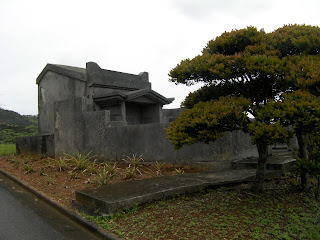Yes, I did get back home on the 19th, so I HAVE been putting it off.
Why though? Because I'm lazy? Well naturally yes, but perhaps more importantly, Okinawa is hard to define and blog about.
To write an entry about this place wouldn't do it justice. And I don't say that because Okinawa is some amazing magical Japanese wonderland where Unicorns poop rainbows, but more because the place is... different.
On mass scale.
For one. Okinawa is a VARIETY of islands. To say I've gone "there" is in itself fairly audacious, because the sheer number of islands are all different. You have islands like "Okinawa Island", which includes Naha, the capital of the prefecture, as well as a fairly large city of around 700,000 people, but then conversely, the "Yaeyama Islands", which are something like 90-95% uninhabited forests with no real cities at all.
I know this is a running theme in my blogs, but a country's "culture" as an idea is one that is hard to define. Okinawa has been blessed with a history that is somewhat separate from Japan, which gives it a variety of characteristics that are otherwise rare in Japanese culture.
But it's still Japan!
How are we getting away with saying "this is how all Japanese people act"?
As an example of differences, first thing I noticed right off the bat.
Buildings have COLOR. Pinks and greens and yellows and reds, Naha is less than inspiring in terms of size or even cleanliness, but some of the buildings in Okinawa just have the most audaciously bright colors I've ever seen.
A Bright Blue with Pink Driving School in Itoman Okinawa
Random house with bright blue and red accents
This sort of stuff seems arbitrary at first, but to me it's striking. Places are just more vibrant.You don't see color like this really anywhere, let alone in Japan. And these shots are all on Okinawa Island, the most touristy spot of them all.
It's quite touristy alright. And at times very grimy and dirty. But everyone knows you have to go elsewhere to see even a glimpse of what this place is like.
Naturally of course, Ryukyu cultural influence is a large part of what Okinawa was today. These islands weren't always Japanese, after all, in fact Japanese involvement with Okinawa is (I believe) only around 400 years. The people of the Ryukyu culture left behind many interesting sights such as castles and temples, which in all honesty, look nothing like anything else found in Japan.
Ryukyu King's hide-away near Castle in Naha
Shrine on Kumejima Island.
So the architecture stems out into quite a variety not really noticed on the main-land. Naturally the differences don't end there.
Nature in Japan has, to be honest, always been awe inspiring. Some of the parks that I've seen here take extreme detail in terms of showcasing the beauty of nature. Okinawa is no exception to this framework, yes, but there are characteristics that seem different.
For instance, a lot of the roads and areas just have lush plantlife sprouting up all over the place.
Sometimes it's almost TOO much.
Furthermore, Okinawa's Peace Memorial Park, dedicated to those who fell in the Battle of Okinawa (including foreigners), is absolutely stunning.
Incredible flowers.
Extremely Scenic
Very spacious and open
Just off the coast, atop a large hill near memorial graves
The area around the Park. There are wind farms around here.
The park, mind you, is located on a spot where tens of thousands of Okinawans committed suicide to avoid imprisonment and or slaughter, as directed by the Japanese government. The beauty of the place then, is rather humbling.
This sense of old world naturalism, stone, ivy, is further implimented as you go out to smaller islands. Consider Kumejima, which I went to and stayed overnight. I think the following image summarizes the island well.
Small clusters of towns surrounded by dense jungle like nature and beaches. Very picture esque. Also very different from Naha, with its big city layout, large arcades and shopping areas. Even Okinawa has separate cultures within itself.
As well, Okinawa has quite a bit of American influence due to the bases located on the main island.
This very American, 1970s diner like "West ward Sightseeing Drive In Restaurant" is located just outside of the park. Notice the crazy crumbled sign. The menue clarifies on it's American influence
It's hard to see, but steak sandwiches and eggs are included on the menu. (Steak sandwich was tasty by the way)
Other forms of American influence CERTAINLY include food.
(Oh god I will try not to talk about food too much, an entire blog about okinanwan food is here)
Many American fast food restaurants not found in Japan can be found in Okinawa.
That's an ad for A&W in Japan.
Food in general tends to skew from the Japanese norm. Sushi isn't very popular here, since sashimi quality fish isn't found off most sub tropical climates (so I've heard), instead a mixture of tropical foodstuffs and chinese/japanese cooking techniques. Unique ingredients like bitter melon, fruits, SPAM even. Pork is immensely popular in Okinawa; I think it was in each one of my meals in some manner or the other. Taco Rice, a combo of taco seasoned beef, lettuce, tomatoes, salsa, over rice, is also popular. Remember that this food is certainly influenced by American military occupation. Soldiers get HUNGRY!
Okinawan Soba is not really soba, more like ramen and udon combined. Pickled ginger, slow cooked pork belly and sparerib, seafood broth.
THAT PORK WAS TASTY!! With mango Juice fyi.
Okinawa is just... different. Even the islands are different from one another!
It's beautiful, and horrifylingly touristy. And was a lovely time. I'll miss it.
Especially AFRO NEST UGH YOU KINGS OF FOOD AND DRINK!
Toodles, more on my life... later. This post is long enough. I'm sure I didn't cover enough about Okinawa, but still, I think this captures a few glimpses.


















No comments:
Post a Comment